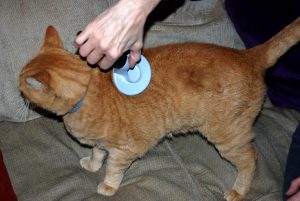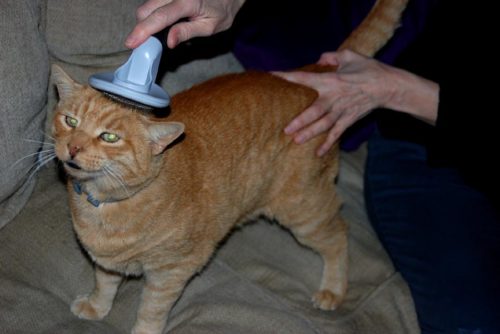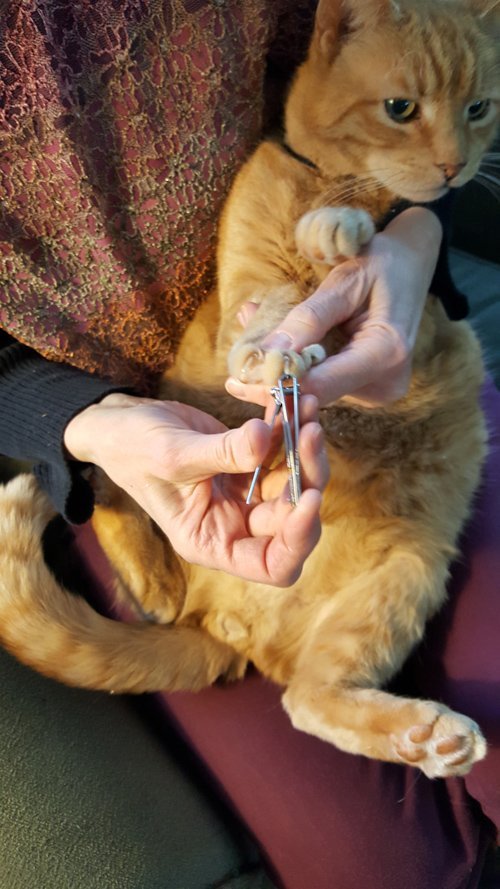


Now there’s a phrase many of us never expected to use but it turns out to be an important skill in the care of these creatures who just wouldn’t let us out of their lives. And it doesn’t take much.
One of the most frequent activities we see cats performing is grooming. They’re good at it, seem to like it and engage in it often. Consequently, many of us have the impression that cats don’t need any additional grooming from us. Very not so. There a variety of problems that can result from an ungroomed cat for both him and you. Fortunately, cats seem to enjoy being groomed and some are obsessed with being brushed.
One of the most frequent activities we see cats performing is grooming. They’re good at it, seem to like it and engage in it often. Consequently, many of us have the impression that cats don’t need any additional grooming from us. Very not so. There a variety of problems that can result from an ungroomed cat for both him and you. Fortunately, cats seem to enjoy being groomed and some are obsessed with being brushed.
The tools we use for cat grooming are: a brush with both bristle length and spacing appropriate for the length of our cats’ fur. Too short for a long-hair cat won’t be very effective – nor as pleasurable and too widely spaced won’t work on a short hair cat; a wide-tooth comb for long haired a fine-toot metal comb and a small pair of good quality, sharp scissors complete the tool kit. The latter is for matted fur – we address that, controversially, further on.So, why do we need to groom our cats?
A cat has his remarkably abrasive tongue, his teeth and his paws and claws to bring to the task of keeping clean and all that goes a long way to keeping his fur in fine fiddle but there is a lot we can do that he can’t, to help in the ongoing effort of cleanliness. For one thing, grooming is not just about cleanliness. And for another, there are important tasks our cats cannot, or cannot easily accomplish by themselves.
It helps when combing cat to know what his fur is like. Most cats have three types of hair: The coarser outer, ‘guard hairs’, the inner coat of medium length ‘Awn hair’ and soft, short ‘down hair’. Different breeds will have these in differing proportions and some cats don’t have one or another of those layers. It is mostly the inner coat that concerns us but the other coats are involved in the process too.

Most specialists recommend brushing in the direction the hair grows but there are those who recommend brushing both directions. This is to be decided by your cat. Try a gentle brushing the ‘right’ way, then try going opposite, very gently. He might like it and it is a good way to increase the massaging effect to the grooming.

If he does like it you’re also stimulating blood flow and distributing his natural oils throughout the area (which happens no matter the direction). If he doesn’t like it you’ll know it, so a respect for his wishes is advised. Anecdotally, we brush our cat, Bijou with a brush that has very fine, metal bristles and he likes it both directions. In fact, he loves it.
For a short hair or medium length, start with the metal, fine tooth comb from head to tail, gently teasing out any knots if there are any but don’t pull. A cat’s skin is very sensitive and causing him pain is antithetical to what you are trying to achieve; (an enjoyable experience for you both that is also beneficial to him). Then use the brush. If you have the right sort of brush he will show considerable pleasure at this and you will be removing the soft, short inner hairs that end up as hairballs he has to regurgitate. Be extra gentle and respectful when brushing delicate areas, like his belly. If you have a long hair cat start with the wide tooth comb, freeing up any knots or tangles, then go to the brush. You can find a lot of really good brushes for long and short haired cats online for under $4.00.

It is not just done with a brush and comb. Playing with your cat also contributes to his grooming by vitalizing his extremeties and nerve endings and don’t forget devices like cat trees. A sisal rope, heavily bottom weighted cat tree is a blessing to your furniture and to your cat. Besides giving him a good stretch a cat tree also help keep his nails in fine order.
Many cat owners are terrified of cutting their cat’s nails. Here is a post with a video of Bijou having his nails trimmed. Depends on the cat of course but it needn’t be a traumatic experience for anybody.